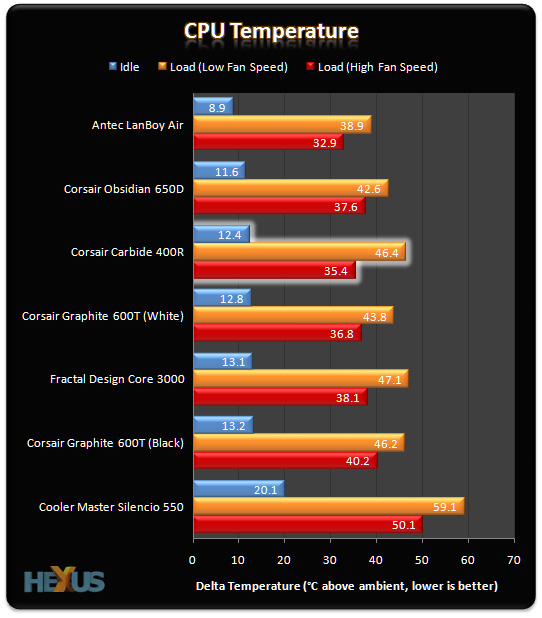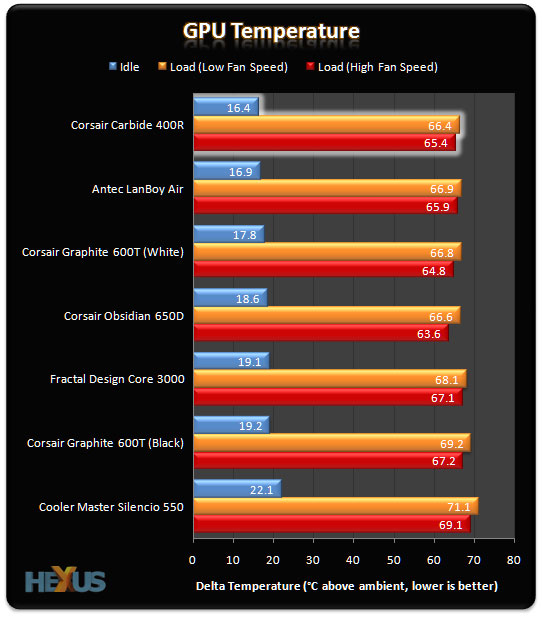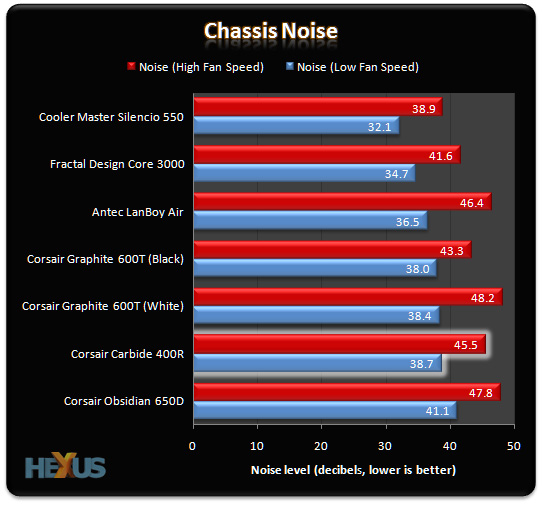Benchmarks
We've established two truths thus far; Corsair's Carbide 400R isn't outwardly the most attractive chassis we've ever seen, but internally, it's a joy to work with. All we need to know now is how well it cools our high-end components, and whether or not it can keep noise levels down to an acceptable minimum.
To find out, we've loaded it up with an X58 test platform and run a series of CPU and GPU benchmarks for comparison against a variety of mid-tower alternatives.
Firstly, CPU cooling performance is measured by setting fan speed to low and recording CPU temperature when the system is idle. We then apply a 15-minute load of the Prime95 stress test and record CPU temperature again. To demonstrate the chassis' optimum cooling capability, we also set all fans - including the CPU cooler - to high speed mode and re-run the Prime95 torture test for a further 15 minutes.
Secondly, GPU temperature is also recorded in three states; idle, load with fans at standard speed and load with fans at high speed. In this test, GPU load is defined as a 15-minute stint of Furmark.
All three chassis are tested only with the standard manufacturer-supplied fans, and to take into account the fluctuating ambient temperature, our graphs depict the delta temperature - that's actual CPU/GPU temperature minus the ambient. Just so we're clear, room temperature at the start of testing was recorded for each chassis as follows:
Fractal Design Core 3000 - 20.9ºC
Cooler Master Silencio 550 - 23.9ºC
Corsair Carbide Series 400R - 24.6ºC
Corsair Graphite Series 600T - 19.8ºC
Corsair Special Edition White Graphite Series 600T - 20.2ºC
Antec LanBoy Air - 18.1ºC
Corsair Obsidian Series 650D - 21.4ºC
Here's a detailed breakdown of the seven enclosures tested, as well as a detailed list of our test system components:
Comparison Chassis |
|||||||
|---|---|---|---|---|---|---|---|
| Fractal Design Core 3000 | Cooler Master Silencio 550 | Corsair Carbide Series 400R | Corsair Graphite Series 600T | Corsair Special Edition White Graphite Series 600T | Antec Lanboy Air | Corsair Obsidian Series 650D | |
| Case type | Mid-tower | Mid-tower | Mid-tower | Mid-tower | Mid-tower | Mid-tower | Mid-tower |
| Dimensions (W x H x D) | 200mm x 430mm x 480mm | 210mm x 416mm x 505mm | 206mm x 503mm x 521mm | 265mm x 507mm x 592mm | 265mm x 507mm x 592mm | 222mm x 518mm x 490mm | 229mm x 521mm x 546mm |
| Weight | 7.1kg | 9.2kg | 7.07kg | 12.7kg | 12.7kg | 9.2kg | 11.11kg |
| Available colours | Black | Black | Black | Graphite Grey and Black | White and Black | Yellow/Black, Red/Black, Blue/Black | Black |
| Base material | Steel | Steel | Steel structure with molded plastic accents | Steel structure with molded plastic accents | Steel structure with molded plastic accents | Steel frame and mesh panels | Aluminium faceplate and steel structure |
| Motherboard support | mini-ATX, mATX, ATX | mATX, ATX | mATX, ATX | mATX, ATX | mATX, ATX | mini-ATX, mATX, ATX | mATX, ATX |
| 5.25in drive bays | 2 | 3 | 4 | 4 | 4 | 3 | 4 |
| 3.5in / 2.5in drive bays | 6 x internal 3.5in/2.5in | 1 x hot-swap 3.5in 7 x internal 3.5in/2.5in |
6 x internal 3.5in/2.5in | 6 x internal 3.5in/2.5in | 6 x internal 3.5in/2.5in | 6 x internal 3.5in 2 x internal 2.5in |
1 x hot-swap 3.5in/2.5in 6 x internal 3.5in/2.5in |
| I/O panel | USB 2.0 x4 Audio x1 Mic x1 |
USB 3.0 x1 USB 2.0 x1 SD Card x1 Audio x1 Mic x1 |
USB 3.0 x2 FireWire x1 Audio x1 Mic x1 |
USB 3.0 x1 USB 2.0 x4 FireWire x1 Audio x1 Mic x1 |
USB 3.0 x1 USB 2.0 x4 FireWire x1 Audio x1 Mic x1 |
USB 3.0 x1 USB 2.0 x2 Audio x 1 Mic x 1 |
USB 3.0 x2 USB 2.0 x2 FireWire x1 Audio x1 Mic x1 |
| Expansion slots | 7 | 7 | 8 | 8 | 8 | 8 | 8 |
| Supplied fans | 1 x 140mm (front) 1 x 140mm (top) 1 x 120mm (rear) |
1 x 120mm (front) 1 x 120mm (rear) |
2 x 120mm (front) 1 x 120mm (rear) |
1 x 200mm (front) 1 x 200mm (top) 1 x 120mm (rear) |
1 x 200mm (front) 1 x 200mm (top) 1 x 120mm (rear) |
2 x 120mm (front) 1 x 120mm (rear) 2 x 120mm (side) |
1 x 200mm (front) 1 x 200mm (top) 1 x 120mm (rear) |
| Power supply | ATX (not supplied) | ATX (not supplied) | ATX (not supplied) | ATX (not supplied) | ATX (not supplied) | ATX (not supplied) | ATX (not supplied) |
| Approx. Price | £55 | £65 | £80 | £120 | £120 | £125 | £130 |
System Configuration |
||
|---|---|---|
| Motherboard | ASUS P6X58D | |
| CPU | Intel Core i7 980X Extreme Edition (with reference DBX-B cooler) | |
| Memory | 6GB (3 x 2GB) Corsair Dominator DDR3 | |
| Graphics card | AMD Radeon HD 6970 | |
| Power supply | Corsair HX1000W | |
| Storage | Intel SSD | |
Thermal performance

Despite being tested on a hot summer day, the Carbide 400R does a good job of preventing our extreme Core i7 980X processor getting too hot under the collar. By cranking the pre-installed fans up to high speed we found the chassis to be a couple of degrees cooler than its costlier Graphite and Obsidian brethren.
Out-the-box performance is more than adequate for high-end CPUs running at their stock frequency, but the 400R should be popular with overclockers who'll no doubt take to the chassis' ability to hold up to 10 fans in total.

The higher-than-usual ambient temperature allows the Carbide 400R to score well in terms of GPU delta temperature, but the graph can be misleading, as our Radeon HD 6970 breezed past 90ºC after 15 minutes of Furmark.
Painting a different picture, actual GPU temperature with fans at high speed was recorded at 85ºC for the Obsidian 650D, 86ºC for the Graphite 600T and 90ºC for the Carbide 400R. These figures suggest that both the Obsidian and Graphite solutions benefit from featuring relocateable hard-drive cages that allow unobstructed airflow to the GPU.
Noise
To find out how loud the Carbide 400R can get we're using a PCE-318 noise meter placed at the front of each chassis to take decibel readings with the system idling in two modes; low fan speed and high fan speed.

Having mesh panels on the front, top and side of the chassis might help aid cooling performance, but it allows more noise to escape.
The acoustics aren't particularly distracting with fans at low speed (it's little more than a constant hum), but turning the fans up to full tilt can make the chassis noisy. Corsair's enclosures have a tendency to favour performance over quiet operation, and the Carbide 400R is another example of that design philosophy.









